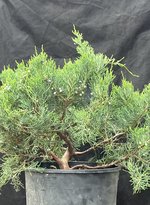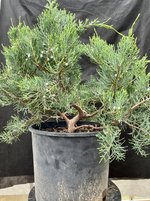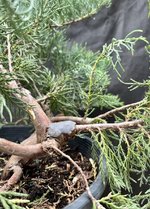You will love grey owl - so bad and so good. (Misbehaved but lovable) I didn't know they were cedar rather than juniper. I have trouble telling them apart especially in spring.
I had found an unusual juniper at the nursery just last year, was not happy with pruning, had weird cones, and finally found photos that identified it as some strange 'male' juniper. Then one day someone posts photos of hinoki cypress and I realized that was the problem, lol.
This is the reason I usually only use botanical names. Common names are misleading and change depending on what part of the world you live in. In North America, we have the native fruit Pawpaw,
Asimina triloba, but in Denmark, Holland, much of the EU and South Africa, Pawpaw is usually thought to mean
Carica papaya, the fruit we in North America call Papaya.
Similarly
Juniperus virginiana is called eastern red cedar, eastern juniper, red juniper and Virginian juniper. Our members in the EU, Japan, Australia or China might not know any of these common names. They have their own species of Juniperus, and our
Juniperus virginiana is likely prohibited from being exported to their countries due to its tendency to be infected with several different rust diseases.
The only true cedars are in the old world genus
Cedrus, Cedrus atlantica, and
Cedrus libani being two of the most well known species, Atlas cedar and Cedar of Lebanon. All other use of term cedar is colloquial and is not botanically correct, British colonizers tended to call any conifer with fragrant wood "cedar" paying zero attention to botanical relationships.
Newer members probably are not familiar with botanical names, so I will go on about this in an effort to help them "catch up". This forum is international in its membership. Many of our members are not native speakers of English. Therefore we should not assume everyone knows what specific species is intended by the use of common names. Here botanical names really help.
So at least once in a post it is helpful to use the botanical name, after which it is perfectly acceptable to fall back to the "common name" once it is clear which botanical name the common name is referring to. To be "totally correct" the botanical name should be italicized and the cultivar name should be in single quotes. In writing for scientific papers additionally the botanical name should be followed by the name or accepted abbreviation of the original author of the name and the year the name was published. But this level of detail is absolutely not necessary for a friendly conversational forum. Even doing the italics is not really needed except if it makes a long paragraph easier to read, in that it separates the botanical name from the rest of the sentence.
Now, back to
Juniperus virginiana 'Grey Owl' - this is an interesting cultivar. It is believed to be a hybrid, but it is not clear what its parentage is. It was found in a flat of
Juniperus virginiana seedlings, and was propagated because of its unique color and growth habit. It is usually listed as
J. virginiana 'Grey Owl' or Juniperus 'Grey Owl' because it is believed one parent is J. virginiana, but its growth habits are different enough from the normal forms of virginiana that it is definitely thought of as a hybrid. This hybrid nature makes it much more acceptable for bonsai. It has been used with a fair amount of success.
The normal form of
Juniperus virginiana has a poor or mixed track record as a bonsai subject. Despite it being a very common shrub east of the Rocky Mountains, there are only a handful of
J. virginiana bonsai that are of "show quality". This is not for lack of trying. It is a difficult species to work with. It tends to keep needle foliage, or if it does develop mature scale foliage, it will often revert back to juvenile foliage with the least little bit of pruning or fertilization. Also,
Juniperus virginiana is very prone to the many varieties of rust, cedar apple rust, cedar pear rust, cedar quince rust and the several other varieties in this family of fungal infections. Infections are difficult to treat, often branches are lost to the fungus, and the juniper on your bench then infects the members of the apple and rose family you might have on your bench.
If you want to work with Junipers, I recommend getting one of the 'Shimpaku' varieties. 'Itoigawa' and 'Kishu' are widely available from bonsai nurseries and are well worth seeking out. They are easy to work with. 'Grey Owl' is okay, but will have some quirky issues due to its
J. virginiana ancestry. I strongly recommend avoiding the normal wild form of
Juniperus virginiana, it will frustrate you over the long run. If you don't believe me, do a side by side comparison, pick up a few 'Kishu' cuttings and run them side by side with some
J virginiana seedlings. In 5 years and 10 years evaluate the differences. The 'Kishu' will win in every category as far as bonsai training is concerned.
There are a small few spectacular J. virginiana in public collections, but generally a species with a poor or problematic tract record.






 had to deal with that. From there, I just cut back the vigorous shoots and have shown the bones of this one.
had to deal with that. From there, I just cut back the vigorous shoots and have shown the bones of this one.
 I love the trunk line, but am going to have to chase foliage back as it’s pretty sparse on the interior.
I love the trunk line, but am going to have to chase foliage back as it’s pretty sparse on the interior. I plan on cutting back to this branch and wiring up for the new leader.
I plan on cutting back to this branch and wiring up for the new leader.







 had to deal with that. From there, I just cut back the vigorous shoots and have shown the bones of this one.
had to deal with that. From there, I just cut back the vigorous shoots and have shown the bones of this one.
 I love the trunk line, but am going to have to chase foliage back as it’s pretty sparse on the interior.
I love the trunk line, but am going to have to chase foliage back as it’s pretty sparse on the interior. I plan on cutting back to this branch and wiring up for the new leader.
I plan on cutting back to this branch and wiring up for the new leader.




